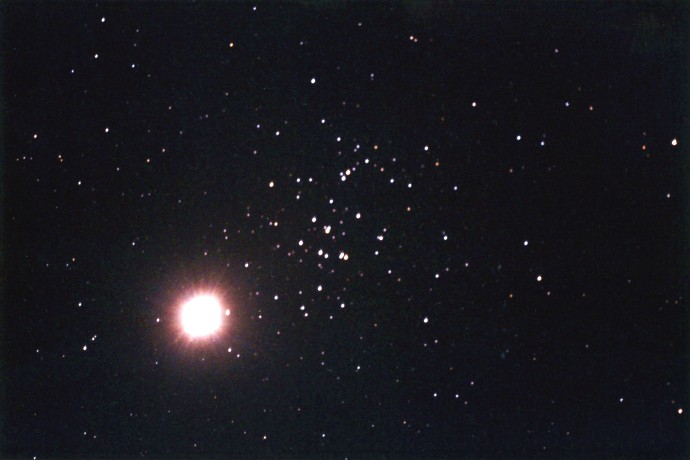Credit & Copyright: TunГ Tezel
Explanation:
If you can find planet Jupiter in tonight's sky, then
you can also find M44,
popularly known as the Beehive
star cluster.
In fact, with a pair of binoculars most casual skygazers should
find it easy to zero in on this
celestial scene.
It should be easy because after sunset Jupiter presently
rules the night
as the brightest "star" overhead.
Now near the
stationary part of its wandering path through
the heavens, Jupiter will obligingly linger for a while at a spot
only a degree or so southeast of M44 in the relatively faint
constellation Cancer.
Seen here in a photograph from March 28, Jupiter (lower left)
is strongly overexposed with the stars of M44 swarming above
and to the right.
The picture approximately corresponds to
the view when looking
through a typical pair of binoculars.
Jupiter is
about 30 light-minutes from our fair planet
while M44, one of the closest star clusters, is around
600 light-years away.
1999 2000 2001 2002 2003 2004 2005 2006 2007 2008 2009 2010 2011 2012 2013 2014 2015 2016 2017 2018 2019 2020 2021 2022 2023 2024 2025 |
Январь Февраль Март Апрель Май Июнь Июль Август Сентябрь Октябрь Ноябрь Декабрь |
NASA Web Site Statements, Warnings, and Disclaimers
NASA Official: Jay Norris. Specific rights apply.
A service of: LHEA at NASA / GSFC
& Michigan Tech. U.
|
Публикации с ключевыми словами:
Jupiter - M 44 - beehive cluster - open cluster - Юпитер - скопление Улей - Рассеянное скопление - star cluster - звездное скопление
Публикации со словами: Jupiter - M 44 - beehive cluster - open cluster - Юпитер - скопление Улей - Рассеянное скопление - star cluster - звездное скопление | |
См. также:
Все публикации на ту же тему >> | |
